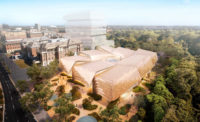 |
| Photo © Oli Scarf/Getty Images |
When the Sydney Olympic bid was initiated in 1990, the then director of the New South Wales Department of Planning said that although the former abattoir site in outer Sydney's Homebush neighborhood was indeterminably toxic and miles from, well, anywhere, it was available, easy, and cheap. There was no attempt to locate Sydney's Olympic Park to achieve strategic benefits for the city. This expediency resulted in a site that remains excruciatingly difficult to reuse.
The park's Olympic village, now a medium-density residential enclave midway between Sydney's two most populous business districts, is so distant from public transportation that most of its families must own two cars. And the broad, sweeping boulevards, for which the Olympic Authority bought up virtually every flowering jacaranda in metropolitan Sydney, remain deserted.
Twelve years after the games, Homebush hosts an annual agricultural Easter Show and the occasional big-stadium event. A number of hotels have been built, like flickers of hope. But the place feels like a ghost town. A small, though elegantly designed, railway station by international design firm Hassell sits largely unused.
It was a great party. But, for Sydney, it's an awfully long morning after.




Post a comment to this article
Report Abusive Comment